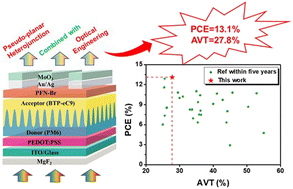High-performance semitransparent organic solar cells enabled by pseudo-planar heterojunction structures combined with optical engineering†
Abstract
Semitransparent organic solar cells (ST-OSCs) are emerging as a promising renewable energy technology for building integration. However, how to solve the trade-off between power-conversion efficiency (PCE) and average visible transmittance (AVT) is always the key point for the further development of ST-OSCs. Herein, a pseudo-planar heterojunction (PPHJ) active layer, by sequentially depositing a polymer donor layer (PM6) and a small-molecule acceptor layer (BTP-eC9), was employed to improve the device performance and AVT, resulting in PCEs of 18.5% for opaque devices and 13.3% for semitransparent OSCs with an AVT of 18.5%. Furthermore, by introducing an effective anti-reflective covering layer, the AVT of the ST-OSCs was further improved up to 27.8% with little minus effect on the PCE (13.1%), as well as an impressive light-utilization efficiency (LUE) of 3.64% and a color-rendering index (CRI) of 94.6. It is worth noting that the PCE of 13.1% is the highest value at an AVT of over 25%. Our strategy represents a unique approach for improving the AVT and PCE of ST-OSCs simultaneously, facilitating the commercial development of OSCs.



 Please wait while we load your content...
Please wait while we load your content...